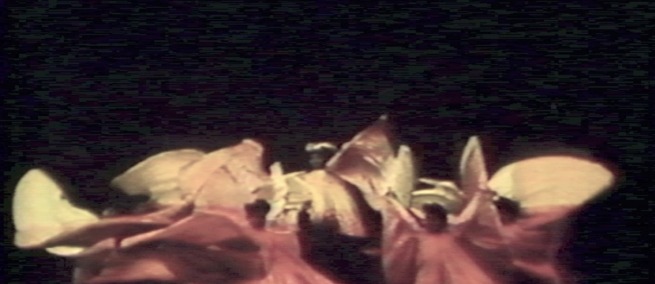
Model of the Art Nouveau aesthetic, Loïe Fuller invented the “serpentine dance” which used arm extensions to swirl yards of fabric creating curvilinear forms reminiscent of forms found in nature. She was an innovator in stage design–integrating mirrors, footlights, and colored gels into performances. Though Fuller only appeared on film three times, her patented serpentine dance was the subject of one of the earliest films. Made by the Lumière Brothers in 1897, DANSE SERPENTINE, is black-and-white with hand-coloring. A person watching Fuller’s dance in a theater would have seen lights in various hues alternately illuminating her dress, so the hand-coloring mimicked this effect for the screen.
Fuller patented a number of the elements which made her serpentine dance unique: hook-shaped wands, held by the dancer to swirl fabric; the dress itself which had a narrow collar and no cinching; an associated crown. She patented theatrical stage techniques to create illusory effects. Fuller received three patents between 1894 and ’95. One of the greatest examples of the serpentine dance on film is a 1907 nine-minute film called BUTTERFLYS.
Seen below in a copy digitized by the Maryhill Museum of Art in Washington, BUTTERFLYS stars a bat man and a butterfly woman. The first six and a half minutes is in the style of a Japanese kabuki dance–it has a narrative, and features women in kimonos, sandals, and with parasols. A woman plays an instrument that is likely a shamisen, a stringed instrument like a guitar but typically with just three strings. The film plays in black-and-white until a woman in a butterfly costume emerges from a cage, and the hand coloring brings her shimmering form into focus–orange wings, a green body, and a glowing antennae crown. But the group of kimono-clad women, along with a man, capture the butterfly woman. In rushes a bat man in black to rescue her. He opens her cage and they begin a duet. They kiss, but the group of women return and the man stabs the bat man, as the room shimmers green.
BUTTERFLYS, produced by the company Cines, in Rome, is reminiscent of an act which Loïe Fuller staged in Paris. For the Universal Exposition of 1900, Fuller created her own theater and programmed Japanese dancer Sada Yacco. Yacco, a former geisha, performed The Geisha and the Knight which Fuller followed with a ten-minute dance of her own. Similarly, the narrative sequence in BUTTERFLYS is followed by a hand-colored sequence featuring a group of women performing the serpentine dance. In the midst of the serpentine dancers is the man who killed the bat man. Though the dance is so beautiful it could hardly seem threatening, the man is ultimately subsumed in the cloud of colored cloths.
Loïe Fuller, born in Fullersberg, Illinois in 1862, moved to Paris in 1892 where she made a name for herself as a performer at the Folies-Bergère before establishing her own company. She was friends with a range of people–from Marie Curie to Auguste Rodin–and sometimes travelled back to the States where she visited her friend Sam Hill, whom she encouraged to found the Maryhill Museum of Art.
Butterflys is from the Collection of the Maryhill Museum of Art